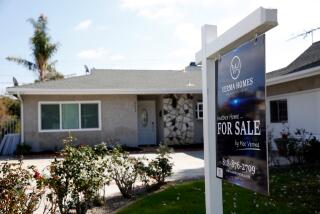Good Year Forecast for Home Buyers
- Share via
In a walnut shell, forecasters agree that 1987 will be a good one for prospective home buyers, but maybe not so good for the people who build them.
Panelists at a recent housing conference here agreed that mortgage interest rates will continue to be favorable for home buyers, but that housing starts will decline about 10% from the approximately 1.84 million new starts in 1986.
But opinions vary widely.
Describing the key as “housing affordability, which is improving,” Chairman Gerald J. Levy of the U.S. League of Savings Institutions considers the outlook to be bright because median household income has been rising, while borrowing rates have been declining. However, faster rising new home prices now are making existing homes more appealing to medium-income buyers.
Taking another tack, savvy housing professionals are already working on ways in which they can live with the new tax legislation. However, chief economist Michael Lea of the Federal Home Loan Mortgage Corp. said recently that the short-term effects of the Internal Revenue Service changes “will probably cause housing costs to increase.”
He cited the combination of lower marginal tax rates, increases in the standard deductions and reductions in non-housing interest deductions as reducing the value of tax breaks for individual homeowners.
Lea predicted that “home ownership costs will rise for all but the very lowest income groups.” He said that, in the short term, “This may depress housing demand and property values and could result in a modest first-year reduction in single-family housing starts.”
He added that rents will have to be increased by an estimated 25% to 30% over current levels for investors to maintain their current levels of after-tax returns on multifamily investments.
The National Assn. of Home Builders predicts that apartment starts will drop 200,000 below the 600,000 level of last year’s multifamily starts.
But that prognosis is far from unanimous. Property management specialist Joseph C. Murray said vacancy rates have been increasing sharply in rental apartment buildings even here, where occupancy rates of 95% were not unusual.
Murray contends that overall, vacancies here are now closer to 10% and that vacancies in less prosperous areas are near 15%. Why? Murray cited high rents that now force a small family to pay almost $1,000 a month for a rental apartment or town house in big cities.
“This has spurred buying because the family that can afford to pay more than $900 a month in rent can afford that much as a monthly mortgage payment on which the mortgage interest is still a worthwhile IRS deduction,” Murray said.
Generally, the outlook for any good volume of multifamily construction in 1987 is bleak due to lack of investment incentives and a weakening demand for rental dwellings.
More to Read
Sign up for Essential California
The most important California stories and recommendations in your inbox every morning.
You may occasionally receive promotional content from the Los Angeles Times.






